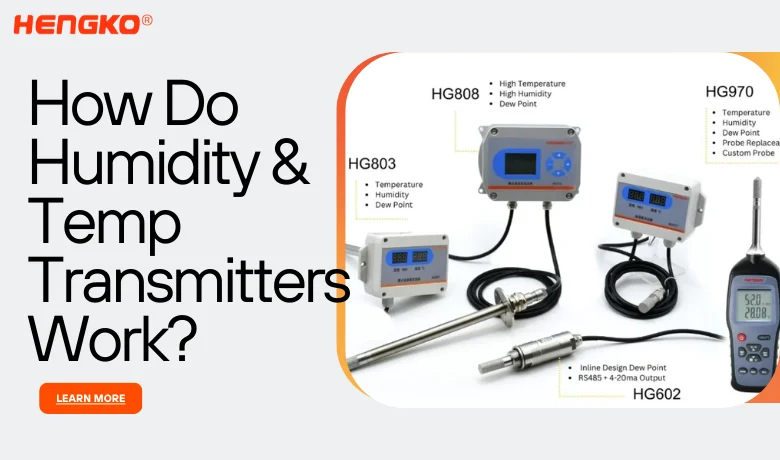Understanding Dew Point Sensors
Imagine a world where condensation unexpectedly forms inside pipes, ruining products or causing equipment failure. That’s where dew point sensors come in – they act as silent guardians against moisture-related problems in industrial settings.
What are Dew Point Sensors?
These sensors are like tiny detectives for water vapor. They measure the dew point, which is the temperature at which air becomes saturated with moisture and condensation forms. By constantly monitoring this critical point, they help prevent unwanted moisture build-up and its associated issues.
Why are Dew Point Sensors Important in Industry?
Here’s why these sensors are essential for various industrial applications:
- Preventing Damage: Condensation can lead to rust, corrosion, and even freezing within pipes. Dew point sensors help maintain optimal dryness, preventing damage to equipment and ensuring smooth operation.
- Optimizing Processes: Many industrial processes, like drying and air separation, rely on precise moisture control. Dew point sensors provide real-time data to ensure products meet quality standards and drying systems operate efficiently.
- Saving Money: Uncontrolled moisture can lead to product spoilage, equipment breakdowns, and unnecessary energy consumption for drying. Dew point sensors help prevent these issues, saving companies money in the long run.
Overall, dew point sensors play a crucial role in maintaining efficient, cost-effective, and damage-free industrial operations.
Overview of Output Types
Dew point sensors, like silent communicators, send their message in the form of electrical signals. Understanding these output types is key to using them effectively. Here, we’ll explore two prevalent options: 4-20mA and Modbus RS485.
1. The Simple and Reliable: 4-20mA Output
- How it Works: Imagine a current flowing through a wire. In a 4-20mA output, the dew point sensor changes the intensity of this current (between 4 milliamps and 20 milliamps) depending on the measured dew point. High dew point corresponds to a higher current, and low dew point translates to a lower current.
- Think of it as a dimmer switch: A weak current signifies a dry environment (low dew point), while a brighter current indicates a more humid condition (high dew point).
- Common Applications: This simple and reliable output is popular in various industrial settings due to its ease of use and resistance to electrical noise. It’s commonly found in:
- HVAC systems: Maintaining optimal humidity levels in buildings.
- Compressed air systems: Preventing moisture build-up in pneumatic controls.
- Chemical dryers: Ensuring proper drying conditions for products.
- Advantages:
- Easy to use: Requires minimal configuration and works with standard power supplies.
- Noise-immune: Less susceptible to electrical interference in industrial environments.
- Cost-effective: A widely available and affordable option.
2. The Multi-Talker: Modbus RS485 Output
- How it Works: This communication protocol allows multiple dew point sensors (and other devices) to share information on a single cable. It’s like having several people talking on a party line, taking turns to send and receive messages.
- Think of it as a party line: The sensor transmits its dew point data as digital messages on the cable, following specific addressing rules to ensure each device receives the correct information.
- Common Applications: Modbus is ideal for complex industrial setups where multiple sensors need to be monitored and controlled from a central location. Applications include:
- Large industrial facilities: Monitoring dew point in various zones of a factory.
- Environmental monitoring systems: Collecting data from a network of dew point sensors.
- Building automation systems: Integrating dew point control into a centralized building management system.
- Advantages:
- Flexibility: Allows for communication with multiple devices on a single cable.
- Scalability: Easily expandable for larger systems with many sensors.
- Advanced features: May support additional functionalities like sensor configuration and diagnostics.
In conclusion, both 4-20mA and Modbus RS485 outputs have their strengths. 4-20mA is a simple and reliable workhorse, while Modbus offers more flexibility for complex systems. Choosing the right output type depends on the specific needs of your industrial application.
Factors to Consider When Choosing an Output Type
Now that you understand the common output types for dew point sensors, let’s explore the key factors to consider when making your choice:
1. Application Requirements:
- Basic monitoring: For simple applications like monitoring humidity in a single location, a 4-20mA output might suffice.
- Complex systems: If you need to manage multiple sensors across a large facility, Modbus RS485 becomes more advantageous.
2. Environment:
- Harsh conditions: In settings with electrical noise, a 4-20mA output’s noise immunity is a plus.
- Long distances: For remote sensors, consider the Modbus RS485’s longer communication range compared to 4-20mA.
3. Accuracy and Response Time:
- Critical processes: If precise dew point measurement and fast response time are crucial, choose a sensor with high accuracy specifications, regardless of output type.
4. Existing Systems:
- Compatibility matters: Ensure the chosen output type is compatible with your existing data loggers, control systems, and monitoring software.
5. Integration Considerations:
- Ease of use: If simplicity is key, a 4-20mA output might be easier to integrate.
- Advanced features: Modbus may offer additional functionalities, but might require more complex setup.
6. Distance and Signal Transmission:
- Short distances: For short cable runs, 4-20mA is a good choice.
- Longer distances: Modbus RS485 is better suited for situations where sensors are spread across a larger area.
7. Communication Range and Signal Integrity:
- Modbus offers longer transmission distances: However, signal integrity can be affected by cable quality and noise.
8. Installation and Maintenance:
- 4-20mA is generally easier to install and maintain due to its simpler setup.
- Modbus requires proper configuration and cable management for optimal performance.
9. Long-Term Considerations:
- Evaluate the ease of troubleshooting and future maintenance needs for each output type.
By carefully considering these factors, you can choose the dew point sensor output best suited for your specific industrial application, ensuring optimal performance, efficient communication, and ultimately, a well-controlled environment.
Comparing 4-20mA and Modbus RS485
4-20mA Output:
Pros:
- Simple and reliable: Easy to use, requires minimal configuration.
- Noise-immune: Less susceptible to electrical interference.
- Cost-effective: Widely available and affordable option.
- Universal compatibility: Works with most standard power supplies and data loggers.
- Easy troubleshooting: Simple output signal makes diagnosing issues easier.
Cons:
- Limited communication: Only transmits one data point (dew point) at a time.
- Point-to-point connection: Requires individual wiring for each sensor.
- Limited scalability: Not ideal for large systems with many sensors.
- Shorter cable lengths: Signal degradation occurs over longer distances.
Modbus RS485 Output:
Pros:
- Multi-drop communication: Allows communication with multiple sensors on a single cable.
- Scalable: Easily expandable for larger systems with many sensors.
- Flexibility: Offers additional functionalities like sensor configuration and diagnostics (depending on specific Modbus variant).
- Longer communication range: Suitable for sensors spread across larger areas.
Cons:
- More complex setup: Requires proper configuration and cable management.
- Susceptibility to noise: Signal integrity can be affected by cable quality and electrical interference.
- Higher cost: May be more expensive than 4-20mA sensors and requires additional hardware (like gateways).
- Potential compatibility issues: Requires ensuring compatibility with existing systems and software.
- Troubleshooting complexity: Diagnosing issues may involve additional steps due to digital communication.
Case Studies:
- 4-20mA in Action: In a paint booth, a 4-20mA dew point sensor monitors humidity levels to ensure optimal drying conditions for a consistent paint finish.
- Modbus Managing Multiple Sensors: A large manufacturing facility utilizes Modbus RS485 to communicate with multiple dew point sensors strategically placed throughout the production line, providing centralized monitoring and control of humidity levels across various zones.
Selecting the Right Output
Step-by-Step Guide:
- Define your application needs: What are you trying to achieve? How critical are precise measurements and fast response time?
- Consider the environment: Will the sensor be exposed to electrical noise or require long cable runs?
- Evaluate existing systems: Are there existing data loggers, control systems, and software that need to be compatible?
- Think about scalability: Do you anticipate needing to add more sensors in the future?
- Budget considerations: Compare the initial and long-term costs of each option.
Checklist of Key Factors:
- Application complexity
- Environment (noise, distance)
- Accuracy and response time requirements
- Compatibility with existing systems
- Scalability needs
- Budget
- Ease of installation and maintenance
Recommendations by Industry/Application:
- HVAC systems: Both 4-20mA and Modbus are suitable, depending on the complexity of the system.
- Compressed air systems: 4-20mA is a common choice due to its simplicity and noise immunity.
- Chemical drying: Modbus might be preferred for larger or geographically spread facilities to manage multiple sensors.
- Environmental monitoring: Modbus is ideal for collecting data from a network of sensors across a wide area.
Conclusion
This guide we has explored the world of dew point sensor outputs, equipping you with the knowledge to choose the right one for your industrial application. Here’s a quick recap:
- Dew point sensors are guardians against moisture-related problems, ensuring optimal dryness in various industrial processes.
- Their output types, 4-20mA and Modbus RS485, communicate dew point data for control and monitoring.
4-20mA shines with its:
- Simplicity and reliability
- Noise immunity
- Cost-effectiveness
- Universal compatibility
However, it’s limited to single-point communication and shorter distances.
Modbus RS485 offers:
- Multi-sensor communication
- Scalability for large systems
- Advanced features (depending on variant)
- Longer communication range
We hope this guide helps you understand how to choose the right dew point sensor with 4-20mA or Modbus RS485 output. If you have any questions or need further assistance, please leave a comment below.
For personalized advice and to find the perfect humidity sensor and transmitter for your needs,
contact HENGKO at ka@hengko.com.





